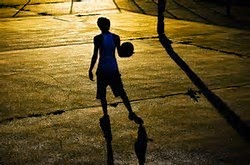One of my favorite things to do is coach my daughter, Gracie, and her team of sweet friends. The funniest thing happened this year at one of her games. I had been trying to teach her how to block out and get a rebound. I modeled how to use your rear to push the defense out of the way. She practiced with me and she told me one day, "Mom, I am really going to try to block out during the game!". I couldn't help but snicker when I glanced out at the floor and noticed her "using her rear to block out" as the girl she was guarding was dribbling the ball down the court! LOL! Well, she had learned part of what I intended to teach her, but bless her good intentioned heart, she missed the part about WHEN to block out! This story reminds me of what we have noticed with lots of our hard-working 4th graders recently. The 4th grade ELAR teachers have really been helping them think through and have good conversations about editing and revising lately. The last couple of weeks, several of the students will be working on comprehending a passage, and begin to try to edit and revise the passage they are reading. Bless them! They have the content they need, they just aren't sure when they need to apply that specific content! These are a couple examples of how important it is for our kids to not only know the information, but also know when to apply that knowledge!
How many of our student's brains probably look like a pile of paper/files all thrown together, with no organization? How many students have NO CLUE which drawer to put different pieces of knowledge into? I have been thinking about this a lot lately, which has led to a light bulb moment for me! This is why our anchor charts and conversations are so important when it comes to new content! If students know what specific genre we are reading or writing and are able to connect it to what they already know about...it's SO MUCH EASIER for them! In Math, if the students know what prior knowledge and vocabulary to pull from to get them started, they are MUCH LESS OVERWHELMED!
Here are a few strategies to help students know what drawer of prior knowledge to pull from:
- Frame the lesson WITH THE SUBJECT. I know that framing our lesson is something we do consistently, but maybe it’s a good idea to even talk about what specific subject we are starting! (This makes me think of how our students had such a hard time with 3 Act Task at first, because they all went to inferring instead of Math thinking!) Maybe this would be a quick, helpful thing for those little guys!
- Refer to/or build ANCHOR CHARTS for new concepts. As we frame the lesson, even just a quick reference and turn and talk to help students pull the correct background knowledge could be very helpful!
- Take the time to help them make the connections. If we slow down and help them see connections between genre, stimuli, vocab, etc. it could help us save time in the long run!
I know that we are ALWAYS strapped for time, but I firmly believe that if we will take the time to support students in this way, we will see DRASTIC improvement in their learning! I have started to commit to spending the time up front to make sure students know which "drawer" (genre) we are in before I dig deep into my guided reading lessons. I have seen my student's confidence soar and their understanding increase tremendously, just by doing this one thing! I wonder if spent more time on this if we would see that maybe students are holding on to more information than we realize? Maybe they just weren't sure when to use it!



















